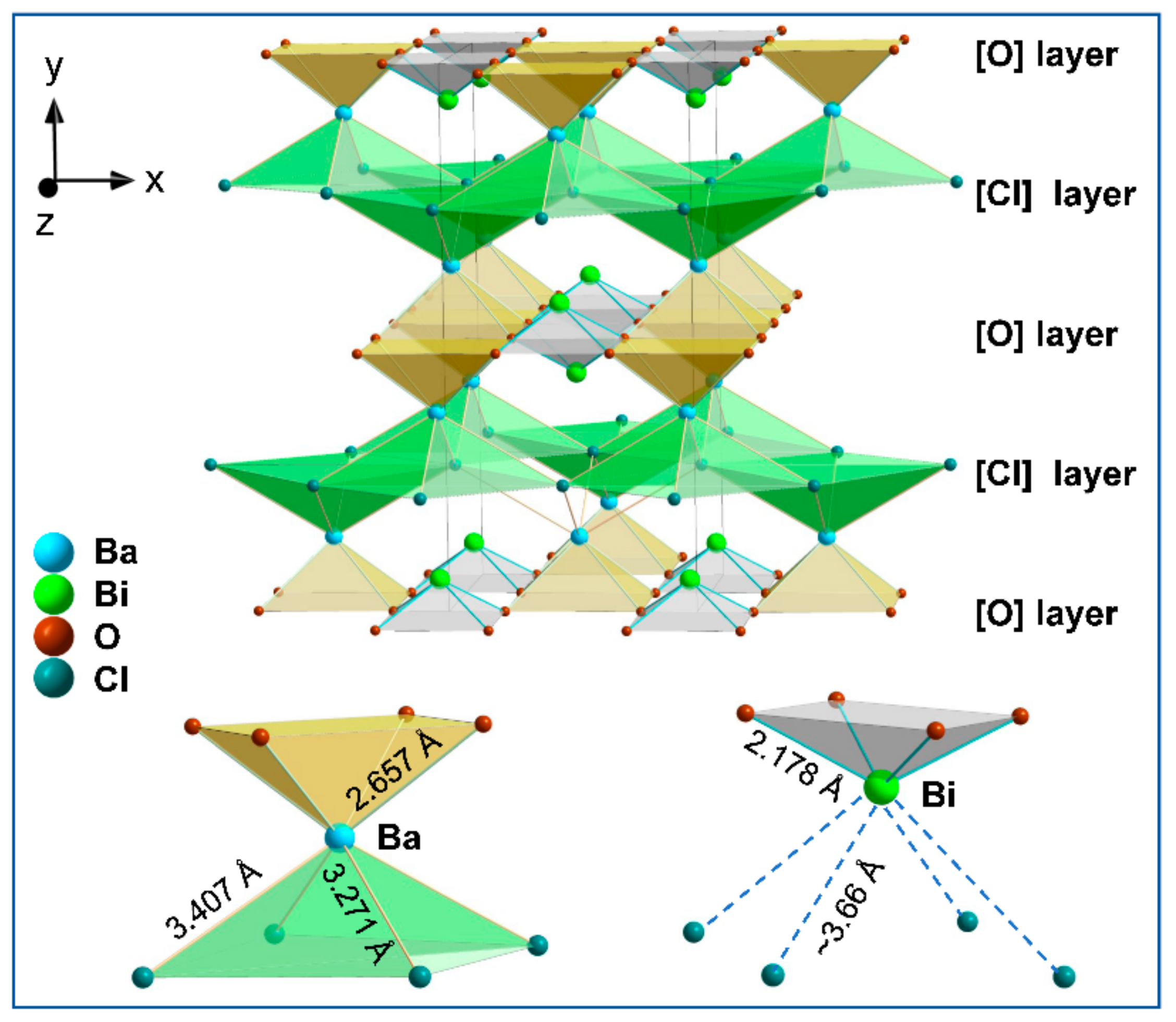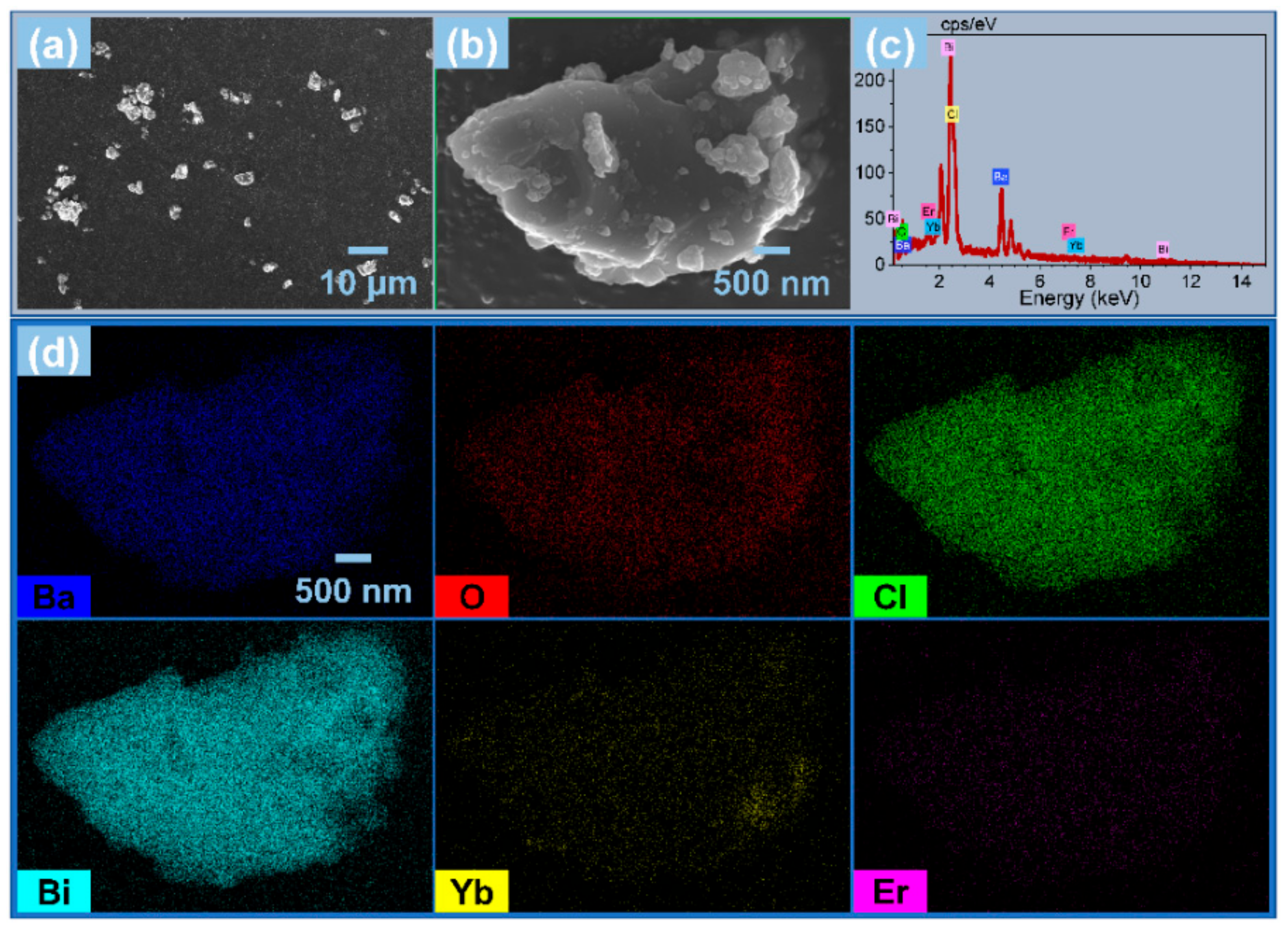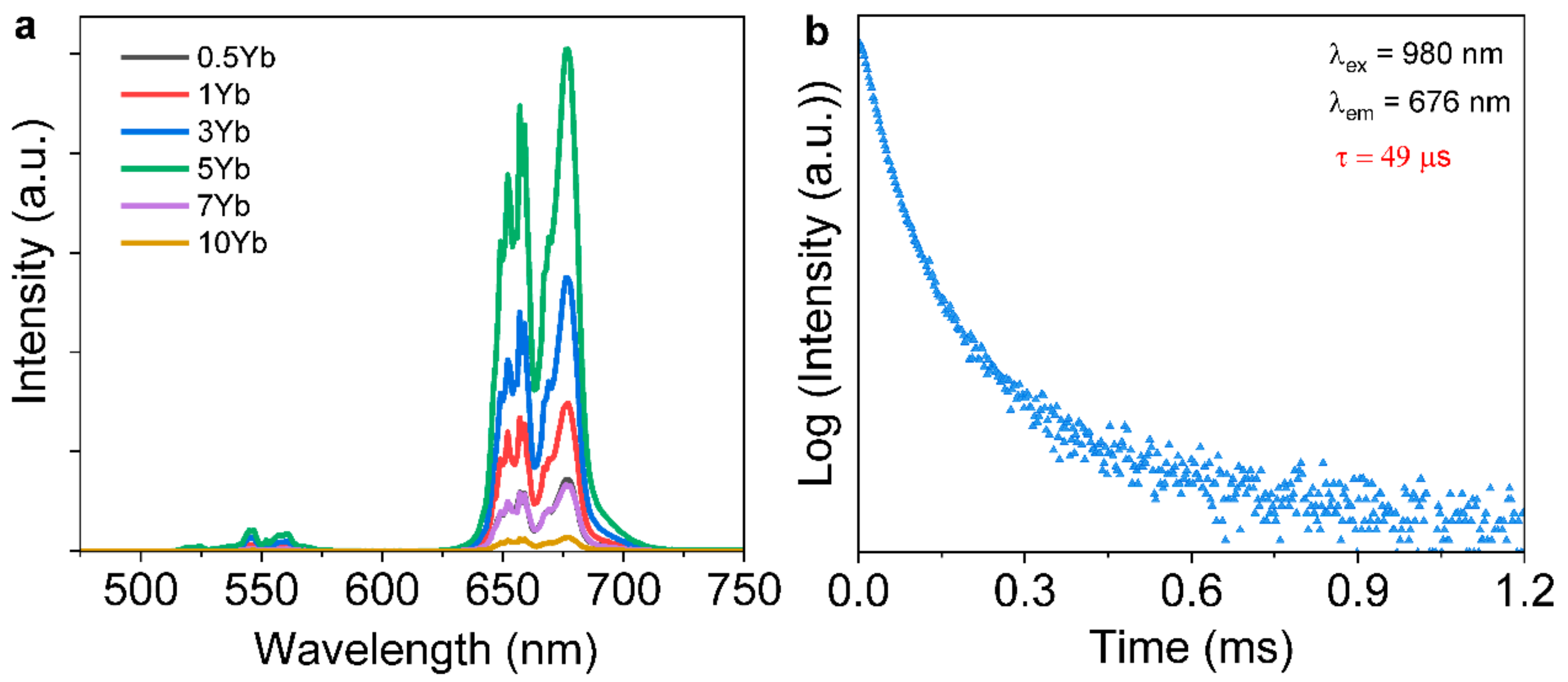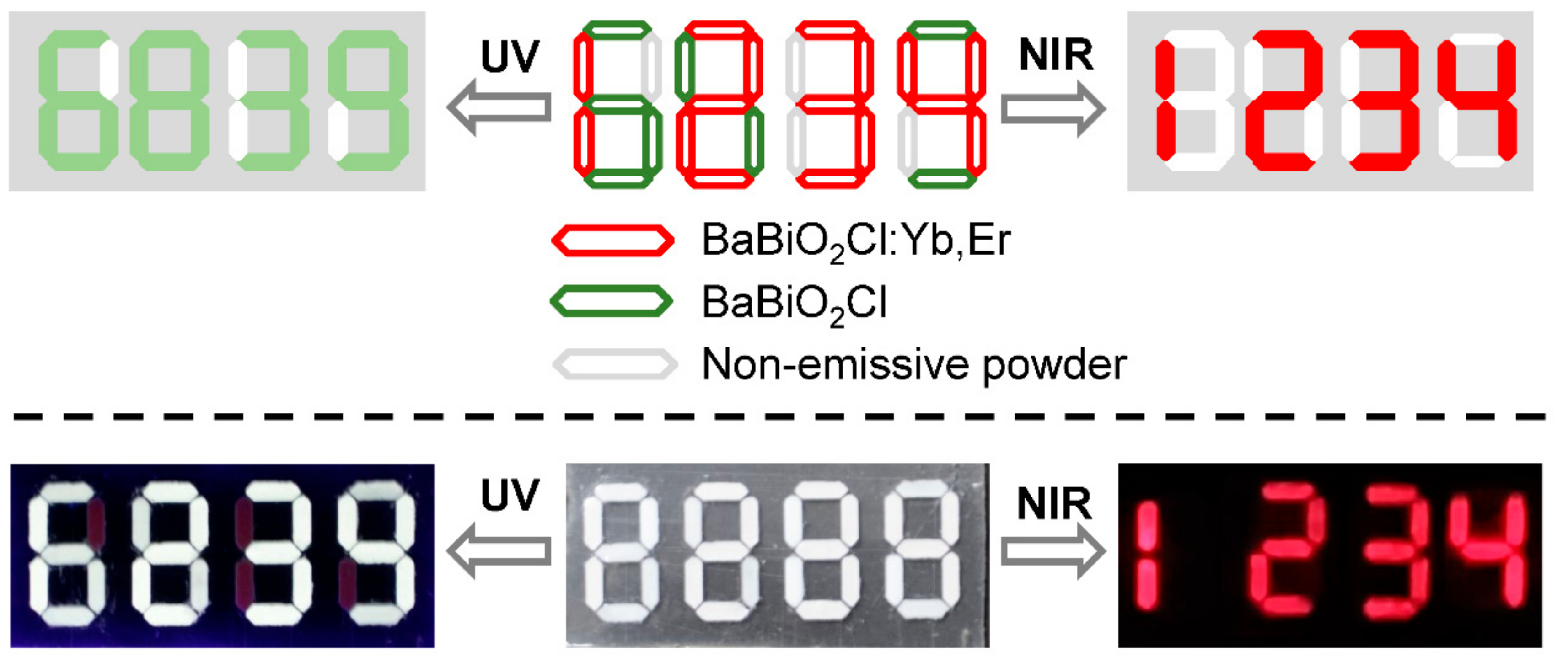Synthesis and Upconversion Luminescence Properties of BaBiO2Cl:Yb3+,Er3+ Phosphor
Abstract
:1. Introduction
2. Experimental
2.1. Materials Synthesis
2.2. Characterization
3. Results and Discussion
Structure Characterization of the BaBiO2Cl:Yb3+,Ln3+ Phosphors
4. Conclusions
Supplementary Materials
Author Contributions
Funding
Data Availability Statement
Acknowledgments
Conflicts of Interest
References
- Auzel, F. Upconversion and anti-stokes processes with f and d Ions in solids. Chem. Rev. 2004, 104, 139–173. [Google Scholar] [CrossRef] [PubMed]
- Zhou, J.; Liu, Q.; Feng, W.; Sun, Y.; Li, F. Upconversion luminescent materials: Advances and applications. Chem. Rev. 2015, 115, 395–465. [Google Scholar] [CrossRef] [PubMed]
- Wang, F.; Liu, X. Recent advances in the chemistry of lanthanide-doped upconversion nanocrystals. Chem. Soc. Rev. 2009, 38, 976–989. [Google Scholar] [CrossRef]
- Haase, M.; Schäfer, H. Upconverting nanoparticles. Angew. Chem. Int. Ed. 2011, 50, 5808–5829. [Google Scholar] [CrossRef] [PubMed]
- Liu, S.; Yan, L.; Huang, J.; Zhang, Q.; Zhou, B. Controlling upconversion in emerging multilayer core–shell nanostructures: From fundamentals to frontier applications. Chem. Soc. Rev. 2022, 51, 1729–1765. [Google Scholar] [CrossRef]
- Tu, L.; Liu, X.; Wu, F.; Zhang, H. Excitation energy migration dynamics in upconversion nanomaterials. Chem. Soc. Rev. 2015, 44, 1331–1345. [Google Scholar] [CrossRef] [Green Version]
- Wilhelm, S. Perspectives for upconverting nanoparticles. ACS Nano 2017, 11, 10644–10653. [Google Scholar] [CrossRef]
- Zhou, B.; Yan, L.; Huang, J.; Liu, X.; Tao, L.; Zhang, Q. NIR II-responsive photon upconversion through energy migration in an ytterbium sublattice. Nat. Photonics 2020, 14, 760–766. [Google Scholar] [CrossRef]
- Huang, X.; Han, S.; Huang, W.; Liu, X. Enhancing solar cell efficiency: The search for luminescent materials as spectral converters. Chem. Soc. Rev. 2013, 42, 173–201. [Google Scholar] [CrossRef] [Green Version]
- Richards, B.S.; Hudry, D.; Busko, D.; Turshatov, A.; Howard, I.A. Photon upconversion for photovoltaics and photocatalysis: A critical review. Chem. Rev. 2021, 121, 9165–9195. [Google Scholar] [CrossRef]
- Zhou, B.; Shi, B.; Jin, D.; Liu, X. Controlling upconversion nanocrystals for emerging applications. Nat. Nanotechnol. 2015, 10, 924–936. [Google Scholar] [CrossRef] [PubMed]
- Suo, H.; Zhu, Q.; Zhang, X.; Chen, B.; Chen, J.; Wang, F. High-security anti-counterfeiting through upconversion luminescence. Mater. Today Phys. 2021, 21, 100520. [Google Scholar] [CrossRef]
- Xie, Y.; Song, Y.; Sun, G.; Hu, P.; Bednarkiewicz, A.; Sun, L. Lanthanide-doped heterostructured nanocomposites toward advanced optical anti-counterfeiting and information storage. Light Sci. Appl. 2022, 11, 150. [Google Scholar] [CrossRef] [PubMed]
- Du, K.; Feng, J.; Gao, X.; Zhang, H. Nanocomposites based on lanthanide-doped upconversion nanoparticles: Diverse designs and applications. Light Sci. Appl. 2022, 11, 222. [Google Scholar] [CrossRef]
- Solanki, P.S.; Balabhadra, S.; Reid, M.F.; Golovko, V.B.; Wells, J.P.R. Upconversion thermometry using Yb3+/Er3+ co-doped KY3F10 nanoparticles. ACS Appl. Nano Mater. 2021, 4, 5696–5706. [Google Scholar] [CrossRef]
- Zhou, Y.; Cheng, Y.; Huang, Q.; Xu, J.; Lin, H.; Wang, Y. Abnormal thermally enhanced upconversion luminescence of lanthanide-doped phosphors: Proposed mechanisms and potential applications. J. Mater. Chem. C 2021, 9, 2220–2230. [Google Scholar] [CrossRef]
- Peng, Y.; Ren, W.; Qiu, J.; Han, J.; Yang, Z.; Song, Z. Upconversion luminescence and temperature sensing properties of layered BiOCl:Er3+ under 1550 nm excitation. J. Inorg. Mater. 2020, 35, 902–908. [Google Scholar]
- DaCosta, M.V.; Doughan, S.; Han, Y.; Krull, U.J. Lanthanide upconversion nanoparticles and applications in bioassays and bioimaging: A review. Anal. Chim. Acta 2014, 832, 1–33. [Google Scholar] [CrossRef]
- Idris, N.M.; Jayakumar, M.K.; Bansal, G.A.; Zhang, Y. Upconversion nanoparticles as versatile light nanotransducers for photoactivation applications. Chem. Soc. Rev. 2015, 44, 1449–1478. [Google Scholar] [CrossRef]
- Duan, C.; Liang, L.; Li, L.; Zhang, R.; Xu, Z.P. Recent progress in upconversion luminescence nanomaterials for biomedical applications. J. Mater. Chem. B 2018, 6, 192–209. [Google Scholar] [CrossRef]
- Qiu, J.; Jiao, Q.; Zhou, D.; Yang, Z. Recent progress on upconversion luminescence enhancement in rare-earth doped transparent glass-ceramics. J. Rare Earths 2016, 34, 341–367. [Google Scholar] [CrossRef]
- Zheng, X.; Kankala, R.K.; Liu, C.G.; Wen, Y.; Wang, S.B.; Chen, A.Z.; Zhang, Y. Tailoring lanthanide upconversion luminescence through material designs and regulation strategies. Adv. Opt. Mater. 2022, 10, 2200167. [Google Scholar] [CrossRef]
- Wang, F.; Liu, X. Multicolor tuning of lanthanide-doped nanoparticles by single wavelength excitation. Acc. Chem. Res. 2014, 47, 1378–1385. [Google Scholar] [CrossRef]
- Liu, D.; Xu, X.; Du, Y.; Qin, X.; Zhang, Y.; Ma, C.; Wen, S.; Ren, W.; Goldys, E.M.; Piper, J.A.; et al. Three-dimensional controlled growth of monodisperse sub-50 nm heterogeneous nanocrystals. Nat. Commun. 2016, 7, 10254. [Google Scholar] [CrossRef] [Green Version]
- Xie, X.; Li, Z.; Zhang, Y.; Guo, S.; Pendharkar, A.I.; Lu, M.; Huang, L.; Huang, W.; Han, G. Emerging ≈800 nm excited lanthanide-doped upconversion nanoparticles. Small 2017, 13, 1602843. [Google Scholar] [CrossRef] [PubMed]
- Back, M.; Ueda, J.; Ambrosi, E.; Cassandro, L.; Cristofori, D.; Ottini, R.; Riello, P.; Sponchia, G.; Asami, K.; Tanabe, S.; et al. Lanthanide-doped bismuth-based fluoride nanocrystalline particles: Formation, spectroscopic investigation, and chemical stability. Chem. Mater. 2019, 31, 8504–8514. [Google Scholar] [CrossRef]
- Lei, P.; An, R.; Yao, S.; Wang, Q.; Dong, L.; Xu, X.; Du, K.; Feng, J.; Zhang, H. Ultrafast synthesis of novel hexagonal phase NaBiF4 upconversion nanoparticles at room temperature. Adv. Mater. 2017, 29, 1700505. [Google Scholar] [CrossRef]
- An, R.; Liang, Y.; Deng, R.; Lei, P.; Zhang, H. Hollow nanoparticles synthesized via Ostwald ripening and their upconversion luminescence-mediated Boltzmann thermometry over a wide temperature range. Light Sci. Appl. 2022, 11, 217. [Google Scholar] [CrossRef]
- An, R.; Lei, P.; Zhang, P.; Xu, X.; Feng, J.; Zhang, H. Near-infrared optical and X-ray computed tomography dual-modal imaging probe based on novel lanthanide-doped K0.3Bi0.7F2.4 upconversion nanoparticles. Nanoscale 2018, 10, 1394–1402. [Google Scholar] [CrossRef]
- Back, M.; Trave, E.; Zaccariello, G.; Cristofori, D.; Canton, P.; Benedetti, A.; Riello, P. Bi2SiO5@g-SiO2 upconverting nanoparticles: A bismuth-driven core–shell self-assembly mechanism. Nanoscale 2019, 11, 675. [Google Scholar] [CrossRef]
- Chen, D.; Zhang, L.; Liang, Y.; Wang, W.; Yan, S.; Bi, J.; Sun, K. Yolk–shell structured Bi2SiO5:Yb3+,Ln3+ (Ln = Er, Ho, Tm) upconversion nanophosphors for optical thermometry and solid-state lighting. CrystEngComm 2020, 22, 4438. [Google Scholar] [CrossRef]
- Back, M.; Casagrande, E.; Trave, E.; Cristofori, D.; Ambrosi, E.; Dallo, F.; Roman, M.; Ueda, J.; Xu, J.; Tanabe, S.; et al. Confined-Melting-Assisted Synthesis of bismuth silicate glass-ceramic nanoparticles: Formation and optical thermometry investigation. ACS Appl. Mater. Interfaces 2020, 12, 55195–55204. [Google Scholar] [CrossRef] [PubMed]
- Chen, D.; Bi, J.; Wang, W.; Wang, X.; Zhang, Y.; Liang, Y. Rapid aqueous-phase synthesis of highly stable K0.3Bi0.7F2.4 upconversion nanocrystalline particles at low temperature. Inorg. Chem. Front. 2021, 8, 1039–1048. [Google Scholar] [CrossRef]
- Chen, D.; Liang, Y.; Miao, S.; Shan, X.; Wang, X.; Wang, W.; Zhang, Y.; Bi, J.; Tang, D. Self-surfactant room-temperature synthesis of morphology-controlled K0.3Bi0.7F2.4 nanoscintillators. J. Mater. Chem. C 2022, 10, 14296–14305. [Google Scholar] [CrossRef]
- Kennard, M.A.; Darriet, J.; Grannec, J.; Tressaud, A. Cation ordering in the sillén X1-type oxychloride, BaBiO2Cl. J. Solid State Chem. 1995, 117, 201–205. [Google Scholar] [CrossRef]
- Charkin, D.O.; Berdonosov, P.S.; Dolgikh, V.A.; Lightfoot, P. A reinvestigation of quaternary layered bismuth oxyhalides of the Sillén X1 type. J. Solid State Chem. 2003, 175, 316–321. [Google Scholar] [CrossRef]
- Sillén, L.G. Röntgenuntersuchung von LiBi3O4Cl2 und verwandten Stoffen. Z. Anorg. Allgem. Chem. 1939, 242, 41–46. [Google Scholar] [CrossRef]






Publisher’s Note: MDPI stays neutral with regard to jurisdictional claims in published maps and institutional affiliations. |
© 2022 by the authors. Licensee MDPI, Basel, Switzerland. This article is an open access article distributed under the terms and conditions of the Creative Commons Attribution (CC BY) license (https://creativecommons.org/licenses/by/4.0/).
Share and Cite
Zhang, Z.; Liang, Y. Synthesis and Upconversion Luminescence Properties of BaBiO2Cl:Yb3+,Er3+ Phosphor. Crystals 2022, 12, 1465. https://doi.org/10.3390/cryst12101465
Zhang Z, Liang Y. Synthesis and Upconversion Luminescence Properties of BaBiO2Cl:Yb3+,Er3+ Phosphor. Crystals. 2022; 12(10):1465. https://doi.org/10.3390/cryst12101465
Chicago/Turabian StyleZhang, Zhuanzhuan, and Yanjie Liang. 2022. "Synthesis and Upconversion Luminescence Properties of BaBiO2Cl:Yb3+,Er3+ Phosphor" Crystals 12, no. 10: 1465. https://doi.org/10.3390/cryst12101465





